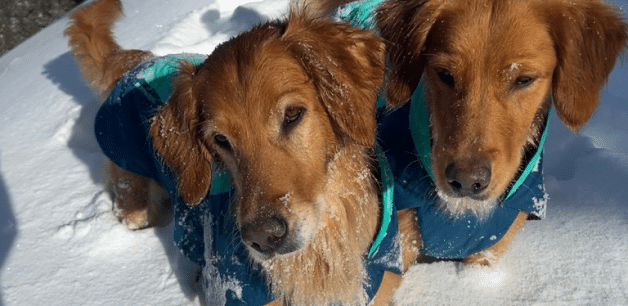Winter Dog Care
As the cooler months roll in, it’s essential to think about how we can best care for our dogs during the winter season. I have a pack of six—two Golden Retrievers and four Cocker Spaniels. As a pet parent, I know that different dogs have varying needs when it comes to cold weather care. Whether you’re taking your dog out for a brisk winter walk or navigating snow-filled paths, preparation is key to keeping them comfortable, safe, and healthy.
In this blog, I’ll share some winter dog care tips and tricks that I use for my pack. It’s important to ensure they stay warm and happy during the colder months, I hope you find them useful!

How Cold is Too Cold for Dogs?
Dog owners often ask me, “How cold is too cold for dogs?” and specifically, “How cold is too cold for a puppy?”. Puppies are more vulnerable to cold weather because they have less body fat and a thinner coat, making it harder for them to regulate their body temperature.
Generally speaking, dogs have different tolerances to cold depending on their size, coat type, age, and health. For example, larger breeds like Golden Retrievers tend to tolerate cold better than smaller, short-haired breeds. My Golden Retrievers are more comfortable on frosty mornings, but my Cocker Spaniels need extra care when the temperatures plummet.
A good rule of thumb is that when temperatures fall below 7°C, it’s time to be cautious. Short-haired dogs, puppies, senior dogs, and those with health issues are especially vulnerable to colder weather. If you’re wondering what temp is too cold for a dog, anything below freezing (0°C) can be risky, especially if your dog isn’t used to cold weather. If you’re ever uncertain, watch for signs of discomfort, like shivering, anxiety, or reluctance to go outside.
Preparing for Winter Walks
Dog safety in cold weather can be challenging, but it’s still important to keep them active and engaged. My dogs love their walks, no matter the season, but I take extra steps to ensure they’re comfortable on chilly days.
Protect those paws: I always check my dogs’ paws before and after a walk in cold weather. Snow, ice, and salt can be tough on their paw pads, so I apply a paw balm or vaseline before heading out. This helps to protect their skin from cracking and prevents ice from getting stuck between their toes. Don’t forget to regularly trim the fur between their paw pads to stop ice from building up in those areas.
Dress for the weather: Not all dogs need a winter coat, but short-haired dogs and smaller breeds can benefit from one. I don’t often need coats for my dogs, but I always ensure I have lightweight, water-resistant jackets to use if I need to, particularly on extra cold or rainy days. It’s essential to make sure any clothing fits well and doesn’t restrict movement.
Shorten walks when necessary: On extremely cold days, I keep our walks shorter than usual. If it’s too cold to walk, I limit outdoor time and focus on indoor activities to keep them mentally and physically stimulated. Never leave your dog outside in freezing weather.

Dogs in Snow: What You Need to Know
Many dogs, like my Golden Retrievers, love playing in the snow. However, dogs in snow require extra supervision. Snow can hide dangers, like sharp objects or frozen patches, which can injure your dog.
Limit exposure to freezing weather: Walking your dog in snow is fun, but don’t let them stay out too long in freezing temperatures. Breeds with thicker coats (such as a Siberian Husky) can handle colder weather better. However, prolonged exposure to icy conditions increases the risk of hypothermia and frostbite, even for the fluffiest of dogs.
Stay visible: Winter months often mean darker mornings and early evenings, so I make sure my dogs wear reflective gear when we head out in the dark. It’s a good idea when walking your dog in snow or low-visibility conditions, ensuring cars and cyclists can see you easily.
Keeping Warm Indoors
Even indoors, it’s essential to keep your dogs cosy. Dogs in freezing weather can lose body heat quickly. After a cold walk, I ensure my dogs have plenty of warm blankets, and I let them snuggle up in front of the fire. This helps them dry off as quickly as possible, as it’s very important to protect your dog from hypothermia.
If you have a particularly drafty house, provide a warm space for your dog to relax, such as a bed positioned away from cold floors or windows. For senior dogs or those with arthritis, a heated bed or blanket can help relieve joint pain and keep them feeling their best.
Keeping Hydrated in Winter
While we tend to associate hydration with the hot summer months, it’s just as important in winter. Dry, cold air can lead to dehydration, especially if your dog spends time playing outside. I always make sure fresh water is available, both indoors and out, so my dogs can hydrate whenever they need to.
When walking dogs in cold weather, take a collapsible bowl and a flask filled with warm water. Many dogs will avoid drinking freezing water when it’s cold, and it’s important to keep your dog hydrated during winter walks.
Always make sure to hydrate your dog’s food, too, especially if it’s dry food or kibble. James & Ella’s Freeze-Dried Raw food is ideal to use as a complete diet or meal topper during the colder months. Its omega 3 and 6-rich formula ensures your dog will benefit from a boost of healthy fats, which will contribute to balanced energy levels and better overall health during Autumn and Winter.

Avoiding Winter Health Issues
Winter weather can exacerbate certain health issues in dogs. Cold days can lead to problems like frostbite and hypothermia, particularly in smaller breeds or dogs with shorter coats. Always keep an eye on how your dog is coping with the cold. If they seem uncomfortable or start to show signs of distress, it’s best to get them inside to warm up.
For dogs with underlying health problems, especially heart or respiratory issues, be extra cautious when heading outside. Colder weather can sometimes trigger health issues, so it’s important to be mindful of how your dog reacts to the chill.
Ensuring Your Dog’s Comfort in Cold Weather
Every dog has different needs when it comes to handling cold weather, but with a little preparation, you can keep your pup safe, comfortable, and happy during the winter months. Whether you’re walking your dog in snow or braving cold winter walks, it’s important to monitor how your dog is coping and make adjustments as needed.
My six dogs thrive in all types of weather, but I always make sure to adapt our routine when the colder months arrive. With the right precautions and plenty of snuggles, winter can be just as enjoyable for your dog as any other season. So, next time you’re asked “What temperature is too cold for dogs?” Hopefully this blog will spring to mind!
Stay safe, and enjoy those crisp, winter walks with dog!
Until next time,
James x
